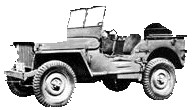
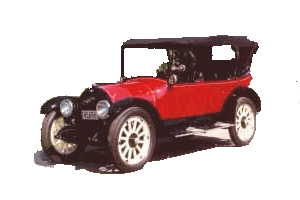
One story has it that the lowly, uninformed GI's thought "GP" was for general purpose, and pronounced it "jeep". Other people say that the word "jeep" was slang for any wonderfully multipurpose thing. The Popeye cartoon had a character, named "Eugene the Jeep" in 1936, who had all kinds of amazing powers. Anyway, the source of the name "Jeep" is now vailed by the passage of time... but on with the story.
The government selected a vehicle based mostly on the design by
the Bantam Car Company. Bantam didn't have the mass production facilities needed
to supply the government, and the military wanted multiple suppliers. Willys got
a contract to build "jeeps" in late 1940. Ford was also awarded a
contract a week later. Many parts were interchangeable between the Willys and
Ford jeeps. Of the roughly half million jeeps produced for WW2, Willys-Overland
made about 360,000 between 1941 and 1945. The jeeps proved to be rugged and
dependable in the war, and by the time the soldiers came home, jeeps were well
known and loved for their durability and unstoppability.
Willys-Overland was not one of the automotive giants in the prewar era, and had
retooled most of their production facilities to jeeps. After the war, production
of passenger cars continued, but the company couldn't ignore the potential
civilian market for jeeps. They filed for a trademark registration of
"Jeep" and began production. The most direct product transition was
the CJ (Civilian Jeep) line. This product was little changed from those that had
"won the war". The first CJ-2A was produced in 1945. The line has
continued from the CJ2 through the CJ3, CJ5, CJ6, CJ7,and CJ8. (They did make a
CJ4 but it was only a prototype that never went into production.) The CJ5 and
CJ7 are the most common, with the CJ7 being a little longer than the CJ5. The
CJ6 and CJ8 were longer wheel base than the CJ7, but they weren't as popular,
and consequently there were fewer of them manufactured. I think there was a
CJ10, but it wasn't sold in the US.
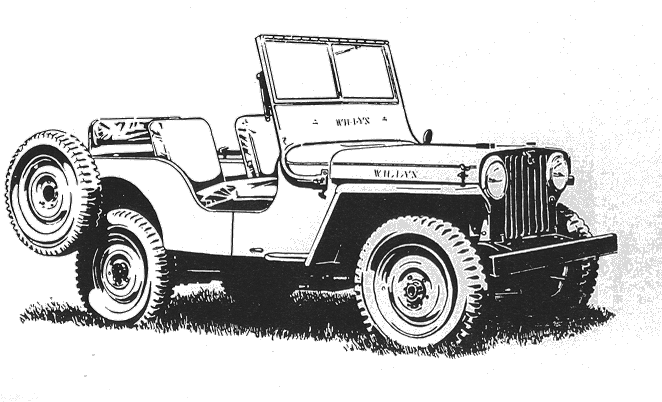 The postal Jeeps are designated as DJ for Dispatcher Jeep. They are 2WD and
most are right hand controls.
The postal Jeeps are designated as DJ for Dispatcher Jeep. They are 2WD and
most are right hand controls.
The Wrangler (YJ & TJ) are direct descendents of the CJ line, so I guess you can say that the original Jeep line is still going. But since 1963 Jeeps have been manufactured by Kaiser, AMC, and Chrysler. So I'm getting side-tracked from the Willys story.
| Model | Years | Quantity |
| CJ-2A | 1945 - 1949 | 214k |
| CJ-3A | 1946 - 1953 | 132k |
| CJ-3B | 1952 - 1968 | 155k |
| CJ-5 | 1954 - 1983 | 611k |
| CJ-6 | 1955 - 1981 | 50k |
| CJ-7 | 1976 - 1986 | 379k |
| CJ-8 | 1981 - 1986 | 28k |
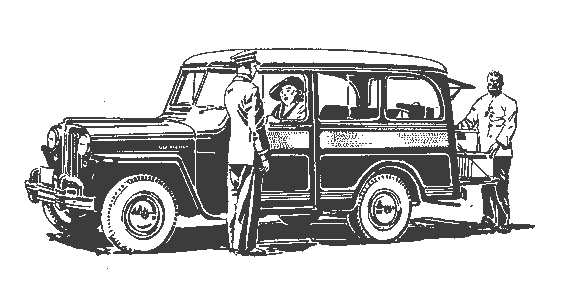
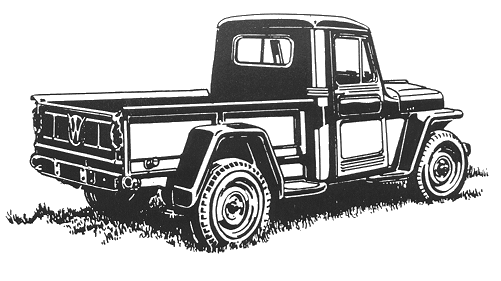
These were called the 'Jeep' Utility Vehicles and all retained clear influences of the military Jeep, but the forms were intermediate between the normal rounded forms of the autos of the period and the boxy Jeep. The wagon was similar to the panel trucks or delivery wagons of the day, but with those unmistakable flat fenders (and later 4WD). The truck was similar in size and functionality of a GMC, Ford or Dodge truck of the day, but once again with the Jeep look and available in 4WD.
The Jeepster was a convertible about half-way between a military Jeep and a
sports car. This two wheel drive vehicle was only made from 1948 to 1950, but
was resurrected by AMC in the '60's as the Jeepster Commando. Some people point
out that the Jeepster was technically a phaetom, not a convertible. A phaeton
was a type of two-door touring car without a solid top. To the common man,
phaeton doesn't mean much. 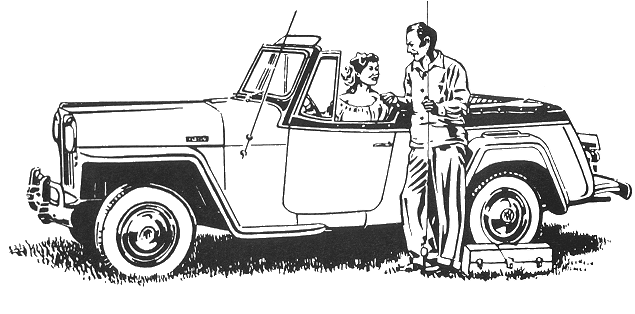
The wagon and pickup truck were available in both 2WD and 4WD with a 4-cylinder or 6-cylinder engine. Kaiser bought Willys-Overland in 1953 and dropped "Overland" from the name. In the 1956, Willys introduced snub-nosed forward control models. Production of Willys wagons and trucks continued under the name of the Willys Motor Company until 1963, when the name was changed to the Kaiser-Jeep Corporation. Production of the Willys wagons and trucks continued for two more years until 1965. Willys had production facilities in Brazil, Argentina, Israel, and India, and Japan . Some of these continued making vehicles that were essentially the same as the Utility vehicles for several more years. But eventually Kaiser sold these. Thus ended the production of those interesting vehicles we call Willys.
If the folks at Willys had known that driving in the dirt was a sport, they would have called them Sport Utility Vehicles, but they didn't, so they were dubbed simply Utility Vehicles. It is up to those of us who came latter to make a sport of driving them. The Willys Utility Wagon is clearly the grand daddy of all modern SUV's. It was a 4WD wagon with enough space inside to load up and go most anywhere.
| Model | Years | Quantity |
| Wagons | 1946 - 1965 | over 300k |
| Trucks | 1947 - 1965 | over 200k |
| Jeepster | 1948 - 1950 | 19k |
Kaiser bought Willys (1953), AMC bought Kaiser (1970), and Chrysler bought AMC (1987). Then Chrysler merged with Daimler in 1998. The Germans who lost the war to the Jeep now own it!